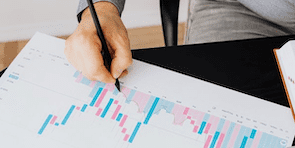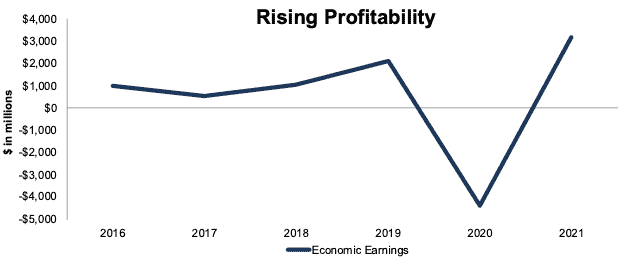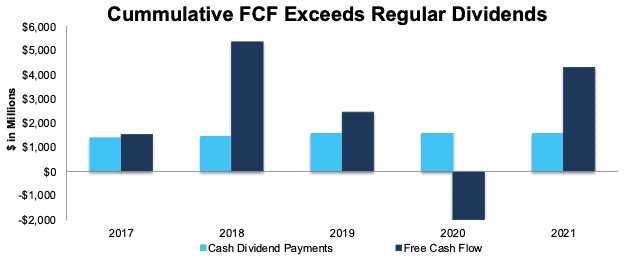Seven new stocks make our Safest Dividend Yields Model Portfolio this month, which was made available to members on April 21, 2022.
Recap from March’s Picks
On a price return basis, our Safest Dividend Yields Model Portfolio (+2.5%) outperformed the S&P 500 (+0.3%) by 2.2% from March 23, 2022 through April 19, 2022. On a total return basis, the Model Portfolio (+2.7%) outperformed the S&P 500 (+0.3%) by 2.4% over the same time. The best performing large cap stock was up 13% and the best performing small cap stock was up 6%. Overall, 15 out of the 20 Safest Dividend Yield stocks outperformed their respective benchmarks (S&P 500 and Russell 2000) from March 23, 2022 through April 19, 2022.
More reliable & proprietary fundamental data, proven in The Journal of Financial Economics, drives our research and provides investors with a new source of alpha. Our proprietary Robo-Analyst technology[1] scales our forensic accounting expertise (featured in Barron’s) across thousands of stocks[2] to produce an unrivaled database of fundamental data.
This Model Portfolio only includes stocks that earn an Attractive or Very Attractive rating, have positive free cash flow and economic earnings, and offer a dividend yield greater than 3%. Companies with strong free cash flow provide higher quality and safer dividend yields because we know they have the cash to support the dividend. We think this portfolio provides a uniquely well-screened group of stocks that can help clients outperform.
Featured Stock for April: Phillips 66 (PSX: $83/share)
Phillips 66 (PSX) is the featured stock in April’s Safest Dividend Yields Model Portfolio. We made Phillips 66 a Long Idea in July 2020. Since then, the stock is up 24% vs. a 28% gain for the S&P 500. See our latest report on Phillips 66 here.
Phillips 66 has grown net operating profit after-tax (NOPAT) by 9% compounded annually since 2016. Phillips 66’s NOPAT margin rose from 4.8% in 2016 to 5.5% in 2021, while invested capital turns improved from 1.8 to 2.0 over the same time. Rising NOPAT margins and invested capital turns drove the company’s return on invested capital (ROIC) from 8% in 2016 to 11% in 2021. Despite a pandemic-driven dip in 2020, the company’s economic earnings rose from $1.0 billion in 2016 to $3.2 billion in 2021, per Figure 1.
Figure 1: Phillips 66’s Economic Earnings Since 2016
Sources: New Constructs, LLC and company filings
Free Cash Flow Supports Regular Dividend Payments
Phillips 66 has paid dividends in each year since 2012 and increased its regular dividend from $2.73/share in 2017 to $3.62/share in 2021. The current quarterly dividend, when annualized, provides a 4.5% dividend yield.
Since 2019, Phillips 66’s cumulative FCF easily exceeds its regular dividend payments. From 2017 to 2021, Phillips 66 generated $11.7 billion (33% of current market cap) in FCF while paying $7.6 billion in dividends, per Figure 2.
Should the economic slowdown in 2022 worsen and the company’s FCF turn negative as it did in 2020, the company's $3.1 billion of cash and cash equivalents provide an extra layer of protection for the dividend. For reference, the company paid $1.6 billion in dividends in 2021.
Figure 2: Phillips 66’s FCF vs. Regular Dividends Since 2017
Sources: New Constructs, LLC and company filings
Companies with strong FCF provide higher quality dividend yields because the firm has the cash to support its dividend. Dividends from companies with low or negative FCF cannot be trusted as much because the company may not be able to sustain paying dividends.
Phillips 66 Is Undervalued
At its current price of $83/share, Phillips 66 has a price-to-economic book value (PEBV) ratio of 0.4. This ratio means the market expects Phillips 66’s NOPAT to permanently decline by 60%. This expectation seems overly pessimistic given that Phillips 66 grew NOPAT by 9% compounded annually over the past five years.
Even if Phillips 66’s NOPAT margin falls to 4% (below 2021 NOPAT margin of 5.5%) and the company’s NOPAT falls by 1% compounded annually over the next decade, the stock is worth $135/share today – a 63% upside. See the math behind this reverse DCF scenario. Should the company grow NOPAT more in line with historical growth rates, the stock has even more upside.
Critical Details Found in Financial Filings by Our Robo-Analyst Technology
Below are specifics on the adjustments we make based on Robo-Analyst findings in Phillips 66’s 10-K:
Income Statement: we made $6.0 billion in adjustments with a net effect of removing $4.8 billion in non-operating expenses (4% of revenue). Clients can see all adjustments made to Phillips 66’s income statement on the GAAP Reconciliation tab on the Ratings page on our website.
Balance Sheet: we made $26.7 billion in adjustments to calculate invested capital with a net increase of $13.6 billion. The most notable adjustment was $10.9 billion (26% of reported net assets) in deferred tax assets. See all adjustments made to Phillips 66’s balance sheet on the GAAP Reconciliation tab on the Ratings page on our website.
Valuation: we made $26.1 billion in adjustments with a net effect of decreasing shareholder value by $25.8 billion. Apart from total debt, one of the most notable adjustments to shareholder value was $5.4 billion in net deferred tax liabilities, which include the deferred tax assets mentioned above. This adjustment represents 15% of Phillips 66’s market value. See all adjustments to Phillips 66’s valuation on the GAAP Reconciliation tab on the Ratings page on our website.
This article originally published on April 28, 2022.
Disclosure: David Trainer, Kyle Guske II, and Matt Shuler receive no compensation to write about any specific stock, style, or theme.
Follow us on Twitter, Facebook, LinkedIn, and StockTwits for real-time alerts on all our research.
[1] Harvard Business School features our research automation technology in the case Disrupting Fundamental Analysis with Robo-Analysts.
[2] See how our models overcome flaws in Bloomberg and Capital IQ’s (SPGI) analytics in the detailed appendix of this paper.


